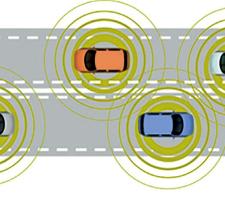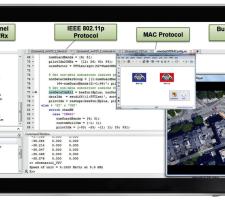
The connected future throws up a number of enticing possibilities for us all. But, says Houman Zarrinkoub of MathWorks, issues around visualisation, prototyping and model evolution need to be examined carefully.
We are all aware of the huge amount of investment going into driverless car technologies. With the likes of
- communications of vehicles to other vehicles (V2V)
- vehicles to the road-side infrastructure (V2I)
- vehicles to pedestrians (V2P)
- vehicles to the cellular network (V2N)
Collectively, these different uses are defined as vehicles to everything (V2X).
Advantages
We are set to see a significant improvement in transportation safety because of V2X. In fact, a report by the
Opportunity
There is a huge potential market for automotive V2X technology. In fact,
- Cellular infrastructure: manufacturers (
6787 Huawei,183 Nokia and5650 Ericsson) and carriers (1970 AT&T, NTT and Docomo) - Devices/semiconductors: RF transceivers and V2X chipset makers such as
8837 Denso,260 Continental,7207 Delphi,213 Qualcomm and6367 Infineon - Automobiles: manufacturers such as
1686 Toyota and1683 Honda (Japan);1959 GM and278 Ford (US); and BMW,2069 Daimler and2125 Audi (Germany)
Technologies
Dedicated short-range communications (DSRC) and cellular vehicle-to-any-device (C-V2X) communications are two candidate technologies suggested for the application of V2X technology. Each is intended to function at the 5.9 GHz band and must comply to stringent dependability and delay conditions as follows:
- Communications range: at least 300m
- Communications latency: less-than-100-ms delay
- Supported vehicular speeds: typical highway velocities
DSRC is essentially an offshoot of Wi-Fi technology. In this type of communication, procedures (PHY and MAC layers) are defined by the
Requirements and workflows
Practitioners of V2X technology include integrators and service providers, testers and performance monitors, and software and hardware developers. However, there are some challenges in developing V2X technologies – namely visualisation, prototyping and model evolution. To overcome these, practitioners must:
- Trial selection collision avoidance and traffic resolution algorithms on V2X chips. This initiative involves not only wireless modem operations handling transmission and reception of basic safety messages, but also collision avoidance algorithms and traffic control messages that are processed by the vehicle in real time.
- Advance their models and monitor the effect of V2X techniques on overall traffic (overall communications metrics such as delays and throughput, status of collision avoidance manoeuvres, algorithms to reroute traffic and dynamics of V2X nodes to optimise a given set of criteria) and constantly look for more optimised techniques based on a huge amount of actual field data.
- Update, visualise and monitor vehicular dynamics and wireless sensor networks (velocity, position, and acceleration of vehicles in network; vehicles entering and exiting the network; status of links between each vehicle; RF signal strength at each vehicle; and other system elements).
Design verification procedures
For traffic safety, we must be able to guarantee that they work exactly as intended before building safety-critical applications and devices like V2X. By using model-based design tools such as MATLAB and Simulink, we can visualise, analyse and test various traffic scenarios and vehicular dynamics and test that the V2X system provides collision avoidance as expected. By using computer simulations, we can construct a model of the system, its components and its environment - and subject the system to rigorous testing. To produce V2X signals that follow either C-V2X or DSRC standards, we must programme wireless modems which can transmit and receive these types of signals. Tools that offer detailed implementations of C-V2X and DSRC signal processing functions include MATLAB add-on products such as LTE System Toolbox and WLAN System Toolbox. Using these functions, users are assured that each modem component works properly and that the vehicular communications work in representative propagation situations.













